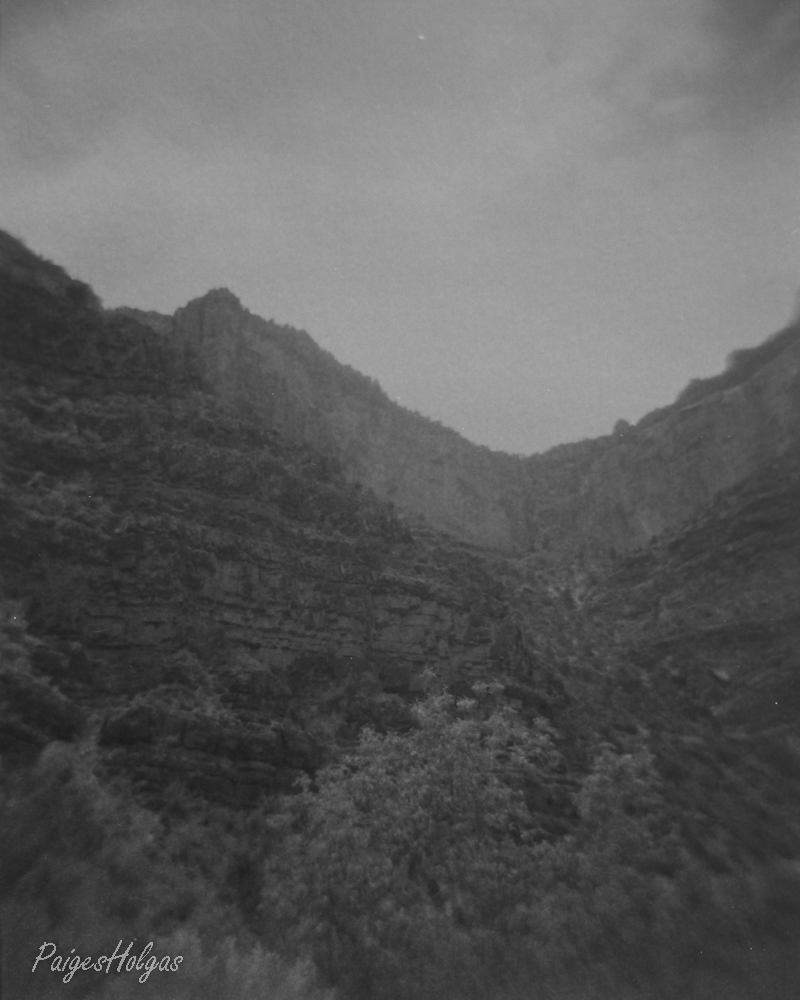Grand Canyon, Holga Style
Since my last post was full of DSLR images from my trip to the Grand Canyon, I thought a post dating back to "vintage" film photography was appropriate! Along with my Canon T3i and wide angle lens, I carried my Holga 120N down the 7 miles of Bright Angel trail down to the Colorado river and back up again. The Holga is essentially a cheap piece of plastic that houses a roll of 120 format film - which you must roll manually (and remember to roll manually after you take a picture!) - and a small plastic lens. But despite it's cheap build, my Holga 120N is one of my favorite pieces of camera equipment. You really never know what is going to come out of your camera when you finally get the film developed - not an easy task in itself for 120 format film nowadays. You might have light leaks, 'ghosts,' extreme vignettes and selective blur. It's amazing and beautiful, and completely serendipitous.
I used 400 ISO black and white Ilford film with my Holga that day. The ISO is a measure of the film's light sensitivity - unlike a digital camera, film isn't 'smart' and doesn't change its sensitivity to light based on your scene. You have to decide before you take your first picture what light sensitivity is appropriate for what you will be shooting, and you buy the appropriate film. The higher the ISO speed, the more sensitive the film is to light. A 400 ISO speed is mid-range, perfect for most situations except for low-light or dim indoor conditions.
The other settings you might be familiar with from digital photography, such as aperture and shutter speed, are also fixed or nearly fixed at particular values for a Holga camera. The shutter speed, or how long the spring-loaded 'door' covering the hole to the film through the Holga's lens is open, is fixed at approximately 1/100th of a second. The aperture, or how big this 'light' hole is, can be varied slightly by adjusting a knob on the front of the Holga. By controlling the size of the hole and what kind of film sits behind it, knowing that the hole is open for 1/100th of a second, the user can control the light sensitivity of the camera and how 'light' or 'dark' the scene will appear on film.
The film itself contains a light-sensitive material made of silver. Simple black and white films are made of several layers, the light sensitive layer consisting of an emulsion of grains of silver-halide - smaller than 1 micrometer, or 10^-6 meters - that absorb light and react with a developing chemical to break down into pure silver that is removed in the film developing process.
'HowStuffWorks' provides a great description of the chemistry of how the grains of silver-halide work in camera film:
The unmodified grains are only sensitive to the blue portion of the spectrum, and they are not very useful in camera film. Organic molecules known as spectral sensitizers are added to the surface of the grains to make them more sensitive to blue, green and red light. These molecules must adsorb (attach) to the grain surface and transfer the energy from a red, green, or blue photon to the silver-halide crystal as a photo-electron. Other chemicals are added internally to the grain during its growth process, or on the surface of the grain. These chemicals affect the light sensitivity of the grain, also known as its photographic speed (ISO or ASA rating).
A fancy way of saying that additional chemicals are added to the silver-halide grains that make them pick up the blues, yellows, oranges and reds that you see with your own eyes in the scene you want to capture on film!
What about developing the film? As it turns out, when those these extra 'chemicals' added to the surface of the silver-halide grains absorb light, they induce free-floating or 'conduction band' electrons in the crystal to become excited and combine with positive holes in the crystal, or places where electrons are missing. The combination of electrons with 'holes' creates single atoms of silver in areas where the film is exposed to light. In chemical processing of the film in a lab, the silver-halide crystal material is removed, leaving behind only areas of pure silver where enough light touched the film. So? You have a 'negative' replication of your original image, where silver atoms remain in the places where there is the most light in your image, for example in the sky or running water!
Who knew there was so much chemistry in photographic film! It seems that the most complicated component of my Holga toy camera is indeed the film that captures my image in shades of black and white. And my, what beautiful landscapes this film chemistry created of my trip to the Grand Canyon.
For more on the chemistry of black and white film processing, visit http://electronics.howstuffworks.com/film7.htm.
All photos (C) Paige's Photography, http://paigesphotos.photoshelter.com/.



